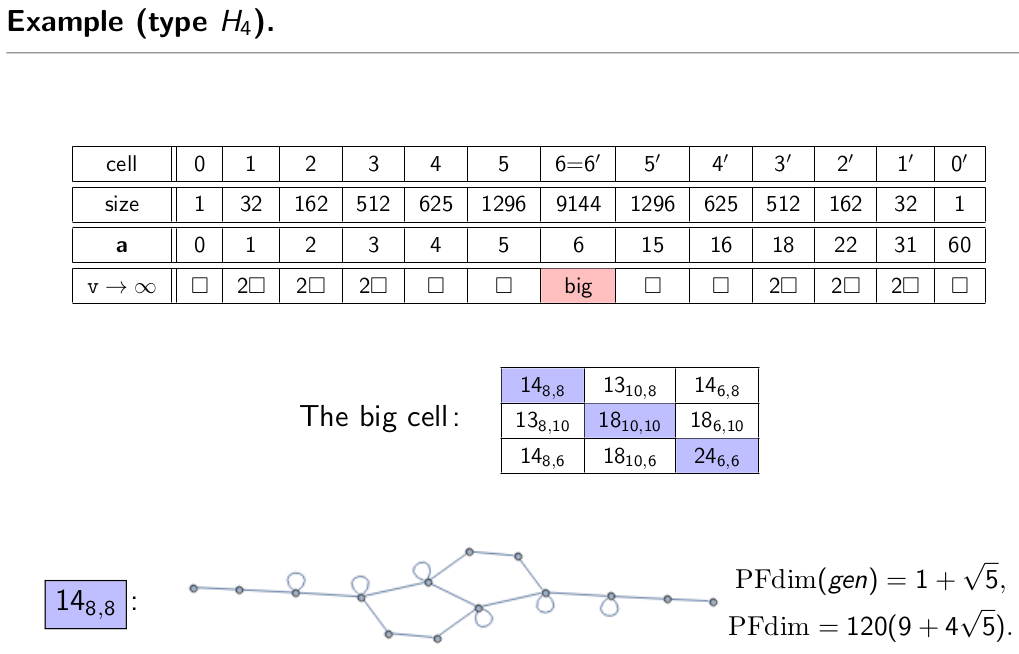Data
- Title: Simple transitive 2-representations of Soergel bimodules for finite Coxeter types
- Authors: Marco Mackaay, Volodymyr Mazorchuk, Vanessa Miemietz, Daniel Tubbenhauer and Xiaoting Zhang
- Status: Proc. Lond. Math. Soc. (3) 126 (2023), no. 5, 1585-1655. Last update: Sun, 12 Feb 2023 08:03:32 UTC
- ArXiv link: https://arxiv.org/abs/1906.11468
- ArXiv version = 0.99 published version
- LaTex Beamer presentation: Slides1, Slides2a (joint with Marco Mackaay Slides2b and Slides2c), Slides3a and companion Slides3b, Slides4 (joint with Vanessa Miemietz Notes), Slides5, Slides6, Slides7
Abstract
In this paper we show that Soergel bimodules for finite Coxeter types have only finitely many equivalence classes of simple transitive 2-representations and we complete their classification in all types but \(H_{3}\) and \(H_{4}\).
A few extra words
Classification problems are among the most important basic problems
in mathematics. For example, classifying simple
representations of Hecke algebras has played an important role in
modern representation theory. The present paper is motivated by
the problem of classifying simple transitive 2-representations
of the 2-category \(\mathcal{S}\) of Soergel bimodules associated to a finite
Coxeter group, which one can see as a categorification
of the classification problem for Hecke algebras.
We do not give a complete answer, but an almost complete answer:
First of all, the Classification Problem for
\(\mathcal{S}\) can be reduced to that of certain subquotients \(\mathcal{S}_{\mathcal{H}}\). To do that, one uses the cell structure
of \(\mathcal{S}\), which is the categorical analog of the Kazhdan-Lusztig cell structure of Hecke algebras.
By apex reduction and \(\mathcal{H}\)-reduction, it suffices to solve the classification problem
for some \(\mathcal{S}_{\mathcal{H}}\) instead of \(\mathcal{S}\).
By the results in this paper, the benefits turn out to be even bigger.
Based on Elias and Williamson's results, there exists a fusion bicategory
\(\mathcal{A}_{\mathcal{H}}\), which categorifies the corresponding asymptotic Hecke algebra.
The main insight of this paper is that these asymptotic bicategories completely determine
the (graded) simple transitive 2-representations of \(\mathcal{S}\). To be precise, our main result
is the existence of a biequivalence of categories of simple transitive 2-representations of
\(\mathcal{S}_{\mathcal{H}}\) and \(\mathcal{A}_{\mathcal{H}}\).
Since \(\mathcal{A}_{\mathcal{H}}\) is semisimple and well-understood in the great majority of cases,
the upshot is that the classification boils down to certain computational data; which
in almost all cases is enough to parameterize the simple transitive 2-representations of \(\mathcal{S}\).
Here is an example how such computational data might look like.

However, assuming our conjecture, types \(H_3\) and \(H_4\) are the only types which would remain open. That is, in all other types our conjecture would give a full classification of 2-simples.
